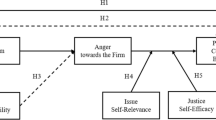Abstract
This study employs a public goods game in which participants can punish each other for free-riding. This paper examines the motivation for punishment behavior when the situation is such that a rational individual will not punish. This paper predicts and finds evidence for the punishment of free-ridership, even when not punishing is the profit-maximizing strategy. Specifically, this paper finds participants will punish more when designated the sole punisher for a group, than when all group members are allowed to punish. This result implies that those individuals who punish for non-rational reasons often free-ride on each others’ punishment. Accordingly, the study suggests individual responsibility is important for ensuring the strength of institutions aimed at punishing selfish behavior.
Similar content being viewed by others
Notes
Throughout the paper, rational and strictly rational are used to describe individuals who seek to maximize their personal monetary gain while assuming that others do the same.
Like non-rational, the term non-strategic indicates punishment that cannot be expected to influence future conditions or behaviors and, therefore, provides no expected monetary gain for the punisher. While rational punishers assume others are also acting rationally, strategic punishers may anticipate non-rational actions from others and work to gain from them. Both rational and strategic behavior aim to maximize monetary gains.
If subjects do not expect to be paired with the same people repeatedly, they should not expect to gain by altering others’ behavior. Accordingly, if concerned only with personal monetary gain, no subjects would punish. In our experiment, small session sizes make it likely that even random group-generation will put individuals in groups together more than once. However, our instructions made clear that punishment had no expected impact on the future and we have no reason to think subjects believed otherwise.
A copy of these instructions is available upon request; please email klim@macalester.edu with the subject line “public goods game instructions”.
Also available upon request.
Recall that each punishment point subtracts an additional 10% from total pre-punishment income.
Free-riding or cheating are used to denote any level of non-contribution to the public pool. Specific definitions of this deviant behavior will be discussed later.
The inclusion of order is meant primarily to control for the possibility that subjects behave differently between the first and second treatment of a day regardless of what these treatments are. We have no theoretical predictions about this coefficient.
For example, take subject A, who contributes ten and is grouped with subjects contributing 7, 2, and 15. The mean contribution for this group is \({{\left( {10 + 7 + 2 + 15} \right)} \mathord{\left/ {\vphantom {{\left( {10 + 7 + 2 + 15} \right)} {4 = 8.5}}} \right. \kern-\nulldelimiterspace} {4 = 8.5}}\). Accordingly, for this round, A’s undermean takes a value of \(\left( {8.5 - 7} \right) + \left( {8.5 - 2} \right) = 8\) and A’s underpun takes a value of \(\left( {10 - 7} \right) + \left( {10 - 2} \right) = 11\). Notice that contributions above the mean are ignored in calculating undermean and contributions above the punisher’s contribution are ignored in calculating underpun. We justify this by assuming that a third party’s generosity does not significantly reduce A’s desire to punish free-riders. However, high contributions may increase the A’s desire to punish, and this effect will be partially reflected in a higher group mean.
Imagine two groups, one with four non-contributing members and one with two high-contributing members and two non-contributing members. Though the first group will have a lower mean contribution, members will also have less incentive to punish because all attempted to free-ride while none were successful. In the second group, the non-contributors free ride on the high contributors and we would expect the high contributors to look down on free-ridership, which actually occurred in this experiment.
References
Anderson, C. M., & Putterman, L. (2006). Do non-strategic sanctions obey the law of demand? The demand for punishment in the voluntary contribution mechanism. Games and Economic Behavior, 54, 1–24.
Decker, T., Stieher, A., & Strobel, M. (2003). A comparison of punishment rules in repeated public good games: an experimental study. The Journal of Conflict Resolution, 47(6), 751–772.
Fehr, E., & Gachter, S. (2000). Cooperation and punishment in public goods experiments. The American Economic Review, 90(4), 980–994.
Gillis, M. T., & Hettler, P. L. (2007). Hypothetical and real incentives in the ultimatum game and Andreoni’s public goods game: An experimental study. Eastern Economic Journal, 33(4), 491–510.
Nikiforakis, N., & Normann, H.-T. (2005). A comparative statics analysis of punishment in public-good experiments. Royal Holloway, University of London Discussion Paper Series. Google Scholar. http://www.rhul.ac.uk/economics/Research/WorkingPapers/pdf/dpe0507.pdf. Accessed 9 March, 2007.
Ostrom, E., Walker, J., & Gardner, R. (1992). Covenants with and without a sword: Self-governance is possible. American Political Science Review, 86(2), 404–417.
Author information
Authors and Affiliations
Corresponding author
Additional information
Special thanks to our advisor and, professor Pete Ferderer, and to professors Paul Hettler and Fahima Aziz for their help and suggestions.
Appendix
Appendix
Rights and permissions
About this article
Cite this article
Devlin-Foltz, Z., Lim, K. Responsibility to Punish: Discouraging Free-Riders in Public Goods Games. Atl Econ J 36, 505–518 (2008). https://doi.org/10.1007/s11293-008-9117-y
Received:
Accepted:
Published:
Issue Date:
DOI: https://doi.org/10.1007/s11293-008-9117-y




